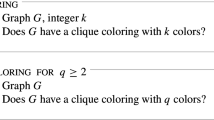Abstract
In this paper we introduce a new algorithm to study some NP-complete problems. This algorithm is a Markov Chain Monte Carlo (MCMC) inspired by the cavity method developed in the study of spin glass. We will focus on the maximum clique problem and we will compare this new algorithm with several standard algorithms on some DIMACS benchmark graphs and on random graphs. The performances of the new algorithm are quite surprising. Our effort in this paper is to be clear as well to those readers who are not in the field.
Similar content being viewed by others
References
R. Battiti and M. Protasi, Reactive Local Search for the Maximum Clique Problem. Algorithmica 29:610–637 (2001).
B. Bollobas, Random Graph (2nd edn.). (Cambridge University Press, 2001).
M. Caramia and G. Felici, Mining relevant information on the Web: a clique based approach, International Journal of Production Research, special issue on Data Mining, accepted 2006.
P. Dankelmanna, G. S. Domkeb, W. Goddardc, P. Groblerd, J. H. Hattinghb, and H. C. Swarta, Maximum sizes of graphs with given domination parameters. Discrete Math. 281:137–148 (2004).
M. R. Garey and D. S. Johnson, Computer and Intractability: A guide to the theory of NP-completeness. (Freeman, New York, 1976).
M. Jerrum, Large cliques elude the metropolis process. Random Struct. Algorithms 3(4):347–359 (1992).
M. Jerrum and A. Sinclair, The Markov chain Monte Carlo method: an approach to approximate counting and integration, in “Approximation Algorithms for NP-hard Problems,” D.S. Hochbaum ed. (PWS Publishing, Boston, 1996).
D. S. Johnson and M. Trick (eds.), Cliques, coloring and satisfiability: Second DIMACS implementation challenge, DIMACS Series in Discrete Mathematics and Theoretical Computer Science, vol. 26, American Mathematical Society, Providence, RI, 1996.
S. Kirkpatric, C. D. Gellatt, and M. P. Vecchi, Optimization by simulated annealing. Science 220:671–680.
M. Mézard and G. Parisi, The cavity method at zero temperature. J. Stat. Phys. 111:1 (2003).
M. Mézard, G. Parisi, and M. Virasoro, Spin Glass Theory and Beyond (World Scientific, 1987).
M. Mézard, G. Parisi, and R. Zecchina, Analytic and algorithmic solution of random satisfiability problems. Science 297:812–815 (2002).
M. Mézard and R. Zecchina, The random K-satisfiability problem: from an analytic solution to an efficient algorithm. Phys. Rev. E 66, 056126-1/056126-27 (2002).
S. Niskanen and P. R. J. Östergärd, Cliquer User's Guide, Version 1.0, Communication Laboratory, Helsinki University of Technology, Espoo, Finland, Tech. Rep. T48, 2003.
J.-C. Régin, Using constraint programming to solve the maximum clique problem. In F. Rossi (ed.), Ninth international conference on principles and practice of constraint programming (CP'03) vol. 2833. Lecture Notes Comput. Sci., pp. 634–648 (2003).
Author information
Authors and Affiliations
Corresponding author
Rights and permissions
About this article
Cite this article
Iovanella, A., Scoppola, B. & Scoppola, E. Some Spin Glass Ideas Applied to the Clique Problem. J Stat Phys 126, 895–915 (2007). https://doi.org/10.1007/s10955-006-9255-z
Received:
Accepted:
Published:
Issue Date:
DOI: https://doi.org/10.1007/s10955-006-9255-z




